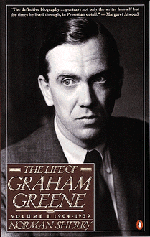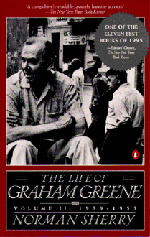| Graham Greene
(1904-1991)
The recurring themes of treachery and betrayal in Greene's writing stem from his troubled school years where he was often tormented for being the headmaster's son. After several suicide attempts, Greene left school one day and wrote to his parents that he did not wish to return. This culminated in his being sent to a therapist in London at age fifteen. His analyst, Kenneth Richmond, encouraged him to write and introduced him to his circle of literary friends which included the poet Walter de la Mare. |
||
| In 1978 Greene gave Professor Norman Sherry a map that marked the spots he traveled to. Sherry spent 20 years retracing Greene's journeys, not without suffering. He contracted diseases from tropical diabetes in Liberia, gangrene of the intestine, to temporary blindness. He won the Edgar Allan Poe award for Best Critical/Biographical Study in 1990 for Volume I of The World of Graham Greene. | Balliol College was Greene's next stop, where he studied modern history. He writes in his autobiography that he spent his university years drunk and debt-ridden. However, it was here that Greene gained experience as an editor at The Oxford Outlook; | |
| developed an interest in politics after joining the
Communist Party (more for amusement than for for principle); and honed his skills at
writing, with one novel Anthony Sant complete before he graduated. After graduating with a B.A. in 1925, Greene was employed as a subeditor at the Nottingham Journal after two abortive positions at other companies. His dislike of Nottingham's seediness manifested in his later novel Brighton Rock. Here he met his future wife Vivien Dayrell-Browning when she wrote to point out some errors regarding Catholicism in his writings. Upon her urging, Greene took instructions in the faith and was received by the Church in 1926. |
||
| Greene moved on to a job as a subeditor at The Times in London. He married Vivien in October 1927 and with her had a daughter, Lucy Caroline, and a son Francis. During this time, he wrote a political novel, The Episode, which was rejected by publishers. He finally succeeded in getting published with The Man Within. The success of the book led Greene to make a difficult decision: leave his much-loved job at The Times and become a self-employed writer. | Michael Shelden's biography of Greene, The Man Within, angered many supporters of the novelist. The book portrayed Greene as a pathological liar, an anti-Semite, a callous womanizer, and a bumbling political rabble-rouser, among other things. It even hinted that Greene may have something to do with the murders in Brighton, which inspired a few plotlines in Greene's writings. | |
| He came near to reneging this decision with the
failure of his next two novels (The Name of the Action and Rumour at
Nightfall). Living on his publisher's advances, he moonlighted as a book reviewer for
The Spectator. The financial strain made Greene write Stamboul Train, an
escapist novel that was deliberately intended to please the public. From then on, he never shied away from writing both "entertainments" and "serious novels".Besides reviewing books, Greene also took on film for The Spectator, and was co-editor of the short-lived Night and Day. He became involved in screenwriting despite being sued by Twentieth Century-Fox for his criticism of Shirley Temple. He wrote adaptations for the cinema as well as original screenplays, the most famous being The Third Man.
The frenetic globetrotting continued until Greene was physically unable to do so in his later years. He sought out the world's "trouble spots": Vietnam during the Indochina War, Kenya during the Mau Mau outbreak, Stalinist Poland, Castro's Cuba, and Duvalier's Haiti among others. |
||
| The differences between Norman Sherry's biography and Michael Shelden's version of it led to a debate between the two in Waterstone's bookshop in Hampstead. Sherry called Shelden a "literary terrorist" and accused his biography of containing over 1000 errors. Shelden tried his best to defend his stance, despite being drowned out by the shouts of many supporters and friends of Greene. | Although Greene always declared himself to be apolitical as a writer, he nonetheless enjoyed being politically connected and appearing to be a supporter for the oppressed. The extent of his involvement in the British Secret Service has become a matter of intense speculation. He | |
| has publicly declared himself a lifelong friend of
Kim Philby, after working under him in the MI6. After the publication of The Quiet
American, Greene was accused of being anti-American and consequently developed a
strong dislike of Americans, particularly Ronald Reagan. He began to delve into Central
American politics, associating with people such as Fidel Castro and Manuel Noriega. His
friendship with Panamanian dictator General Omar Torrijos led him to write Getting to
Know the General. Aside from his exotic trips, Greene also achieved notoriety in his personal life. Greene's financial success as an author enabled him to live very comfortably in London, Antibes, and Capri. He associated with many famous figures of his time: T.S. Eliot, Herbert Read, Evelyn Waugh, Alexander Korda, Ian Fleming, Noel Coward, among others. He had many extra-marital affairs, and confessed he was "a bad husband and a fickle lover", although he never revealed his affairs in his two autobiographies. He separated from his wife in 1948 but they never divorced. Towards the end of his life, Greene lived in Vevey, Switzerland with his companion Yvonne Cloetta. He died there peacefully on April 3, 1991. © Melody Yiu Images and quoted text on this website may be protected by U.S. and international copyright laws. They are presented here for academic interest and personal entertainment. No distribution, reproduction, re-transmission or other rights are given or implied by their appearance. If you have any copyright concerns, please notify me. |
||
 Henry Graham Greene was born on October 2,
1904 in Berkhamsted, Hertfordshire. The fourth of six children, Greene was a shy and
sensitive youth. He disliked sports and was often truant from school in order to read
adventure stories by authors such as
Henry Graham Greene was born on October 2,
1904 in Berkhamsted, Hertfordshire. The fourth of six children, Greene was a shy and
sensitive youth. He disliked sports and was often truant from school in order to read
adventure stories by authors such as  Greene began his world-renowned traveling in part to satisfy his lust for
adventure, and in part to seek out material for his writing. A trip to Sweden resulted in England
Made Me. A exhausting 400-mile trek through the jungles of Liberia not only gave
Greene a near brush with death, but provided fodder for Journey Without Maps.
During World War II, he worked for the Secret Intelligence Service in Sierra Leone, which
became the setting for The Heart of the Matter. His journey to Mexico to witness
the religious purges in 1938 was described in The Lawless Roads. Greene's horror
of the Catholic persecution in Mexico led him to write The Power and the Glory,
arguably the best novel of his career. It was both acclaimed (being the Hawthornden Prize
winner in 1941) and condemned (by
Greene began his world-renowned traveling in part to satisfy his lust for
adventure, and in part to seek out material for his writing. A trip to Sweden resulted in England
Made Me. A exhausting 400-mile trek through the jungles of Liberia not only gave
Greene a near brush with death, but provided fodder for Journey Without Maps.
During World War II, he worked for the Secret Intelligence Service in Sierra Leone, which
became the setting for The Heart of the Matter. His journey to Mexico to witness
the religious purges in 1938 was described in The Lawless Roads. Greene's horror
of the Catholic persecution in Mexico led him to write The Power and the Glory,
arguably the best novel of his career. It was both acclaimed (being the Hawthornden Prize
winner in 1941) and condemned (by